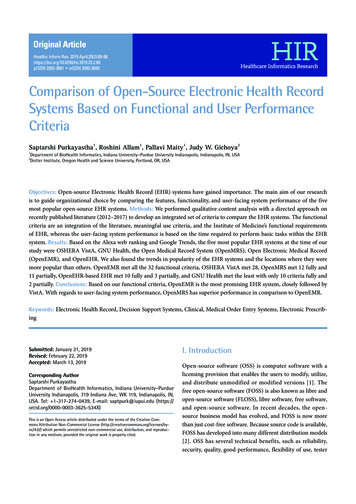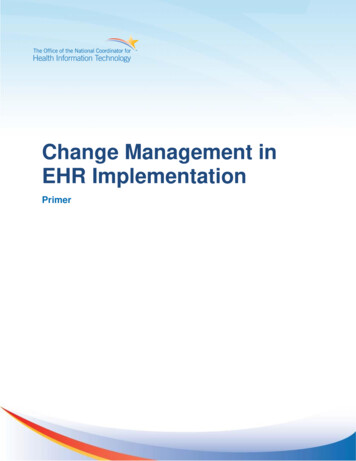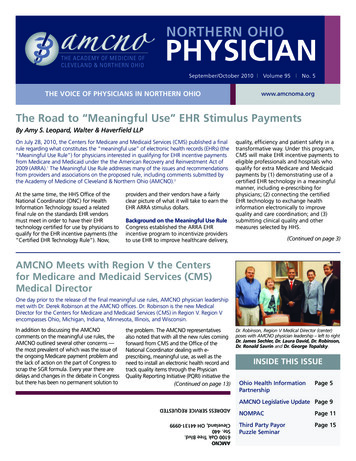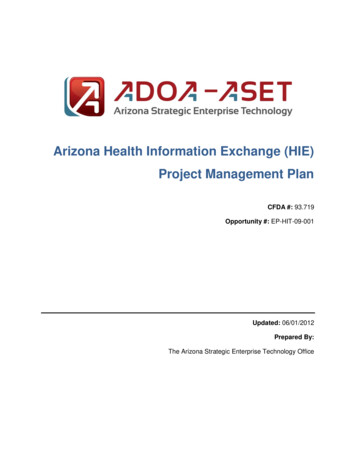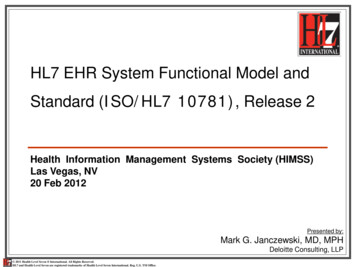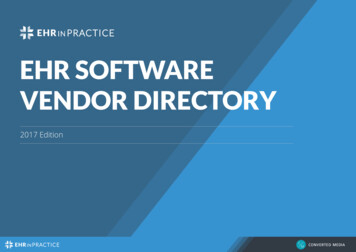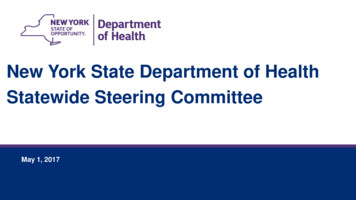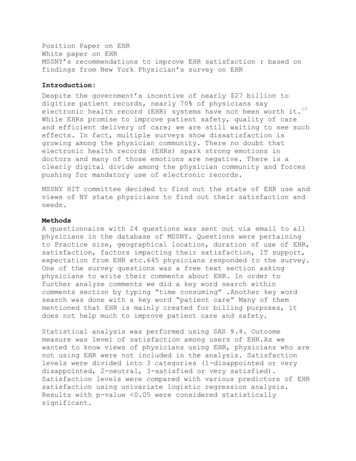
Transcription
Position Paper on EHRWhite paper on EHRMSSNY’s recommendations to improve EHR satisfaction : based onfindings from New York Physician’s survey on EHRIntroduction:Despite the government’s incentive of nearly 27 billion todigitize patient records, nearly 70% of physicians sayelectronic health record (EHR) systems have not been worth it. 17While EHRs promise to improve patient safety, quality of careand efficient delivery of care; we are still waiting to see sucheffects. In fact, multiple surveys show dissatisfaction isgrowing among the physician community. There no doubt thatelectronic health records (EHRs) spark strong emotions indoctors and many of those emotions are negative. There is aclearly digital divide among the physician community and forcespushing for mandatory use of electronic records.MSSNY HIT committee decided to find out the state of EHR use andviews of NY state physicians to find out their satisfaction andneeds.MethodsA questionnaire with 24 questions was sent out via email to allphysicians in the database of MSSNY. Questions were pertainingto Practice size, geographical location, duration of use of EHR,satisfaction, factors impacting their satisfaction, IT support,expectation from EHR etc.645 physicians responded to the survey.One of the survey questions was a free text section askingphysicians to write their comments about EHR. In order tofurther analyze comments we did a key word search withincomments section by typing “time consuming” .Another key wordsearch was done with a key word “patient care” Many of themmentioned that EHR is mainly created for billing purposes, itdoes not help much to improve patient care and safety.Statistical analysis was performed using SAS 9.4. Outcomemeasure was level of satisfaction among users of EHR.As wewanted to know views of physicians using EHR, physicians who arenot using EHR were not included in the analysis. Satisfactionlevels were divided into 3 categories (1-disappointed or verydisappointed, 2-neutral, 3-satisfied or very satisfied).Satisfaction levels were compared with various predictors of EHRsatisfaction using univariate logistic regression analysis.Results with p-value 0.05 were considered statisticallysignificant.
Results:More than 53% of physicians are disappointed or verydisappointed with their EHR.Top 3 reasons for disappointments are1) Takes too much time (66.85%)2) Distracts from patient care (62.92%)3) Negative changes to workflow (43.82%)21% physicians said they are not interested in using EHR.Top 3 reasons for not choosing EHR are1) Interference with doctor –patient relationship (59%)2) Incentives and Penalties are not worth it (44%)3) Costly (42%)Analysis of free text section showed that 27 physicians talkingabout EHR interfering with patient care and workflow and 18physicians say that EHR is more time consuming.Results of univariate analysis: comparing physicians who aresatisfied or very satisfied or neutral to physicians who aredisappointed or very disappointed, are given in table 1.Satisfactionlevelsatisfied vsdisappointedneutral vsdisappointedsatisfied vsdisappointedneutral vsdisappointedsatisfied vsdisappointedneutral vsdisappointedsatisfied vsdisappointedneutral vsdisappointedPredictors forsatisfaction among usersof EHREHR can e-prescribe vsdoes not e-prescribeEHR can e-prescribe vsdoes not e-prescribeEHR can generate reportsvs unable to generatereportsEHR can generate reportsvs unable to generatereportsEHR support p4p vs donot support p4pEHR support p4p vs donot support p4pparticipating in p4pprograms needing EHRreports vs not needingEHR reportsparticipating in p4pprograms needing EHROddsRatioEstimatesOdds RatioConfidenceIntervals2.3130.8061.2-4.4580.430 1.5114.4662.6597.503P-value0.01220.5019 00010.4971
satisfied vsdisappointedneutral vsdisappointedsatisfied vsdisappointedneutral vsdisappointedsatisfied vsdisappointedneutral vsdisappointedsatisfied vsdisappointedneutral vsdisappointedsatisfied vsdisappointedneutral vsdisappointedsatisfied vsdisappointedneutral vsdisappointedsatisfied vsdisappointedneutral vsdisappointedsatisfied vsdisappointedneutral vsdisappointedsatisfied vsdisappointedreports vs not needingEHR reportsEHR prompts gaps inpatient care vs do notprompt gaps in patientcareEHR prompts gaps inpatient care vs do notprompt gaps in patientcare)EHR support and guideMU-2 vs do not supportand guideEHR support and guideMU-2 vs do not supportand guideEHR use duration 5years vs 1 yearEHR use duration 5years vs 1 yearEHR use duration 1-5years vs 1 yearsEHR use duration 1-5years vs 1 years3.1182.01-4.837 .00010.8380.4821.4560.5313.5231.9976.215 .0001EHR type- web vs server0.757EHR type- web vs serverEHR use-independentpractice vs hospital andindependent practiceEHR use-independentpractice vs hospital andindependent practiceEHR use-hospital vshospital and independentpracticeEHR use-hospital vshospital and independentpracticeIT support-IT departmentvs own IT serviceIT support-IT departmentvs own IT serviceIT support-hired ITservices vs own .77480.23950.82040.02310.04060.00080.9501
neutral vsdisappointedsatisfied vsdisappointedneutral vsdisappointedsatisfied vsdisappointedneutral vsdisappointedsatisfied vsdisappointedneutral vsdisappointedserviceIT support-hired ITservices vs own ITserviceIT support-Provided bycombination of ITservices vs own ITserviceIT support-Provided bycombination of ITservices vs own ITservicepractice type- 50physician group vs 10or solo physician grouppractice type- 50physician group vs 10or solo physician grouppractice type-11-50physician group vs 10or solo physician grouppractice type-11-50physician group vs 10or solo physician 81Table 1: showing results of univariate analysis comparingphysicians who are satisfied or very satisfied or neutral tophysicians who are disappointed or very disappointed.Discussion:While electronic health records are now an inherent part ofhealth care, physicians tend to have a hard time accepting theirusefulness. There are many predictors which decide physicians’acceptance and satisfaction to EHR use. Some of the predictorswe found significantly associated with physician’s satisfactionwith use of EHR are below in the table.
oddsratio4.466Predictor of satisfactionP ValueEHR can generate reports vs unable togenerate reports .0001EHR use duration 5 years vs 1 year4.4150.0109EHR support p4p vs do not support p4p3.8250.0001EHR support and guide MU-2 vs do not support3.523and guide .0001EHR prompts gaps in patient care vs do not3.118 .0001prompt gaps in patient careEHR can e-prescribe vs does not e-prescribe2.3130.0122participating in p4p programs, need EHR1.735reports vs not needing EHR reports0.0119Table 2: Predictors of EHR satisfaction among users of EHRTime factor:Majority of physicians who are not satisfied with EHR are mainlydue to more time consumption in documenting patient's’ andbilling related information. 1-4 our results also support thisfinding.In the past, medical records were primarily used in order todocument the patient’s narrative and the physician’s thoughtprocess. Pointing and clicking, along with standardized macros,often will not adequately or accurately replicate a patient'sstory in his words, nor does it explain what the provider wasthinking at the time of the interaction. Similarly, theincreased volume of the current EHR adds little value to theclinical practice of a physician or the helpfulness of hisdocumentation. In order to find pertinent information regardingthe topic at hand, a physician will often have to dive deep intoa patient’s chart and wade through a mass of irrelevantdocumentation prior to finding the information he needs. ThoughEMRs make reports readable, they simply demand too much time time that is dedicated to reading documents that do not addcurrent or clinically relevant knowledge .23There is a significant reduction in productivity due to EHRs aswell. While it is acknowledged that such problems exist due topoor workflow and that significant efforts are being made toimprove such workflow, these efforts have not reached most EHRusers. Face to face time is important, and better systems mustbe developed in order to allow physicians to use handhelddevices, though such innovations are unlikely to be available inthe near future.
Duration of EHR use:Our results also showed that physicians who are using EHR formore than 5 years are more likely to be satisfied while comparedwith physicians who are using it for less than a year ofduration which further supports the fact EHR satisfaction amongusers also depends on their expertise and comfort with EHR.Solo practice vs Group Practice: Who makes the decision?Our results also found that solo physicians or group of lessthan ten physicians who are using EHR tend to be more satisfiedthan group of physicians who are more than 50.A study publishedin 2013 showed that smaller practices need more assistance toimplement EHR. 1, 2, 5 and another study published by Al Alawi andcolleagues showed that solo practitioners are less likely toadopt EHR when compared with group practitioners. 1, 2, 5, 6. Asthere are ambiguities in findings from other studies, we stillneed more studies to conclude anything about practice size andsatisfaction among users of EHR.IT Support:We also found that physicians who perform their own IT servicesfor EHR are more likely to be satisfied with EHR use whencompared with Physicians who have an IT department to supporttheir EHR issues. It may be because physicians who areperforming their own IT services should be more computers savvyand also more independent in solving EHR problems as they arise.Articles supporting this finding are not available so furtherstudies are needed to support or refute our findings. Our studyalso found that physicians who are using EHR both at, inpatientand outpatient locations are more satisfied than physicians whoare using it only in hospitals which suggest that EHRimplementation to outpatient practices should increase toimprove physician’s satisfaction and adoption of EHR. Our resultis also supported by article published by Ash, J.S andcolleagues. It mentioned that having direct flow of patientinformation between7inpatient and outpatient practicesimproves user's satisfaction.Functionality of EHR: Ability to generate reportsWe also found that if EHR supports generation of routine reportsto help better manage patients with diabetes or hypertension orsuggest for due in flu shot, supports and guides to achievemeaningful use-2 requirements, allow e-prescribing, prompting
for gaps in patient care and also assist in generating reportsfor p4p programs which require EHR mediated report generation;users’ satisfaction increases many fold. We could not foundarticles confirming or refuting these findings so furthertesting should be done before we come to conclusion.Cost:Incentives offered by the government are not enough to cover thecosts of EHR installation, as several studies estimate the costof purchasing and installing an electronic health record (EHR)ranges from 15,000 to 70,000 per provider 18-22 so manyphysicians are hesitant to initiate use or make changes to theirEHR. Our survey also found that among physicians not interestedin using EHR, 40% don’t want to use EHR due to higher cost ofimplementation and maintenance. Based on our survey and otherstudies, cost of EHR should come down to increase acceptance andsatisfaction of users.Interference with Patient-Doctor relationship:EHR takes more time to document. It also at times compelprovider to turn away from the patient and makes patient feelthat physician is distracted and less interested in patient. Theproportion of time physicians spent gazing at medical recordsduring EHR visits was significantly more than in paper chartvisits.14 PCPs who spent more time in the consultation gazing atthe computer and whose visits had more conversational silencewere rated lower in patient-centeredness.15Workflow:Physicians want their EHR systems to be more user-friendly andadaptable to individual clinic workflow. 16 we also found thatimproper workflow is the reason for more than 40% physicians’dissatisfaction with EHR. American academy of orthopedic surgeonsmentioned in their position statement “Recognize the differentneeds and uses of EHR by disparate medical specialties,especially the differences between surgical specialties andprimary care specialties”.24Further testing can be done usingcontrolled clinical trials to see effect of changing workflow(according to needs of users)on EHR acceptability andsatisfaction among users.Interoperability:The lack of interoperability among EHR systems is hampering theelectronic exchange of health information and is causing bothfrustration and skepticism among physicians relative to thevalue of EMRs.16
Limitations:Limitations of our study are: not knowing participants’ age, sexand country of medical school training which are importantrecognized predictors of EHR satisfaction among its users.6 Itonly has opinions of New York State physicians so it may not beapplicable to physicians of other states. Larger studies withmore physicians from possibly all states of United States can becarried out to improve validity and larger applicability ofstudy findings.Conclusion:The survey of 600 physicians makes it clear that there is needto improve the current EHR systems.EHRs have failed to deliver on the promise of making the life ofthe provider better and keeping the patient safer. The cost ofimplementation of EHRs adds a financial burden to physicianpractices, which detracts from their appeal amongst the medicalcommunity at large. We also need to reduce unnecessary burden byregulatory agencies.While many innovative products are actively being developed, itis a crucial time to think about what physicians desire fromtheir EMRs, and why. Currently, documentation with regards toEHRs is primarily used for billing purposes. Billing is based ona formulaic documentation of systems and bullets. This methodforces a physician to create a lengthy document and tosystematically repeat the same points upon every documentation.Copy and paste represents another similar problem, as suchdocumentation does not add to the value of the EHR record. WhileEMRs can create a very long note for billing, they evidently donot improve the quality of patient care.Recommendations to improve implementation and satisfaction amongusers’ of EHR (Based on our survey findings and supported byevidence from cited articles):1. Improve design and workflow so thata. EHR doesn’t take away time spent with patientsb. does not interfere with doctor-patient relationshipandc. Reduce total time spent on EHR per patient. 7-92. Workflow should be customizable not only to fulfil variousneeds of different specialties but also to accommodateneeds of every individual physician.
3. Reduce documentation that serves functions other than careof patients and reconsider incentives and penalties 2,7,94. Reduce cost of EHR 2,3,9,95. EHR should help generate necessary billing reports andallow e-prescription of medications6. EHR should prompt physicians about gaps in care of theirpatients and also help with clinical decision support 8,810,10,10,10-137. Improve interoperability between physicians and allhealthcare providers. Peer to peer exchange should be thegoal whether it’s direct or through an exchange.8. Improve value of notes in telling the patient’s story andthe thought process of the physician rather than the volumeof data.9. EHR should capture episodes of care rather than encountersBibliography1. Al Alawi S, Al Dhaheri A, Al Baloushi D, Al Dhaheri M,Prinsloo EA. Physician user satisfaction with an electronicmedical records system in primary healthcare centres in al ain:A qualitative study. BMJ Open. 2014; 4(11):e005569-2014-005569.doi: 10.1136/bmjopen-2014-005569 [doi].2. Lakbala P, Dindarloo K. Physicians' perception and attitudetoward electronic medical record. Springerplus. 2014; 3:63-18013-63. eCollection 2014. doi: 10.1186/2193-1801-3-63 [doi].3. Asan O, D Smith P, Montague E. More screen time, less facetime - implications for EHR design. J Eval Clin Pract. 2014;20(6):896-901. doi: 10.1111/jep.12182 [doi].4. Montague E, Asan O. Physician interactions with electronichealth records in primary care. Health Syst (Basingstoke).2012;1(2):96-103. doi: 10.1057/hs.2012.11 [doi].5. Ancker JS, Singh MP, Thomas R, et al. Predictors of successfor electronic health record implementation in small physicianpractices. Appl Clin Inform. 2013; 4(1):12-24. doi: 10.4338/ACI2012-09-RA-0033 [doi].6. Xierali IM, Phillips RL,Jr, Green LA, Bazemore AW, Puffer JC.Factors influencing family physician adoption of electronichealth records (EHRs). J Am Board Fam Med. 2013; 26(4):388-393.doi: 10.3122/jabfm.2013.04.120351 [doi].
7. Ash JS, Bates DW. Factors and forces affecting EHR systemadoption: Report of a 2004 ACMI discussion. J Am Med InformAssoc. 2005; 12(1):8-12. doi: M1684 [pii].8. Kuhn T, Basch P, Barr M, Yackel T, Medical InformaticsCommittee of the American College of Physicians. Clinicaldocumentation in the 21st century: Executive summary of a policyposition paper from the american college of physicians. AnnIntern Med. 2015;162(4):301-303. doi: 10.7326/M14-2128 [doi].9. Menachemi N, Collum TH. Benefits and drawbacks of electronichealth record systems. Risk Manag Healthc Policy. 2011;4:47-55.doi: 10.2147/RMHP.S12985 [doi].10. Cusack CM, Hripcsak G, Bloomrosen M, et al. The future stateof clinical data capture and documentation: A report from AMIA's2011 policy meeting. J Am Med Inform Assoc. 2013;20(1):134-140.doi: 10.1136/amiajnl-2012-001093 [doi].11. Kaushal R, Shojania KG, Bates DW. Effects of computerizedphysician order entry and clinical decision support systems onmedication safety: A systematic review. Arch Intern Med.2003;163(12):1409-1416. doi: 10.1001/archinte.163.12.1409 [doi].12. Miskulin DC, Weiner DE, Tighiouart H, et al. Computerizeddecision support for EPO dosing in hemodialysis patients. Am JKidney Dis. 2009;54(6):1081-1088. doi:10.1053/j.ajkd.2009.07.010 [doi].13. Mullett CJ, Evans RS, Christenson JC, Dean JM. Developmentand impact of a computerized pediatric antiinfective decisionsupport program. Pediatrics. 2001;108(4):E75.14 Asan O1, D Smith P, Montague E. More screen time, less facetime - implications for EHR designJ Eval Clin Pract. 2014 Dec;20(6):896-901. doi:10.1111/jep.12182. Epub 2014 May 19.15 Street RL Jr1, Liu L2, Farber NJ3, Chen Y4, Calvitti A5,Zuest D6, Gabuzda MT3, Bell K7, Gray B5, Rick S5, Ashfaq S5,Agha Z8. Patient Educ Couns. 2014 Sep;96(3):315-9. doi:10.1016/j.pec.2014.05.004. Epub 2014 May 14.Provider interactionwith the electronic health record: the effects on patientcentered communication in medical encounters.16 Stephen L. Meigs, Perspect Health Inf Manag. 2016 Winter;13(Winter): 1d. Published online 2016 Jan 1.PMCID: PMC4739443 Electronic Health Record Use a Bitter Pill forMany Physicians17 HealthIT on EHR incentives and rofessionals/ehr-incentivescertification Accessed March 28, 2016.18 Blumenthal D, Glaser JP. “Information Technology Comes toMedicine.”Web Site Disclaimers N Engl J Med. 2007.19 Smith PD. “Implementing an EHR System: One Clinic’sExperience.”Web Site Disclaimers Fam Pract Manag. 2003.
20 Fleming NS, Culler SD, McCorkle R, Becker ER, Ballard DJ.“The Financial And Nonfinancial Costs Of Implementing ElectronicHealth Records In Primary Care Practices.”Web Site DisclaimersHealth Aff. 2011.21 Miller RH, Sim I, Newman J. "Electronic Medical Records:Lessons from Small Physician Practices Web Site Disclaimers"[PDF - 477.3 KB]. iHealth Reports. 2003.22 Bodenheimer T, Grumbach K. “Electric technology: a spark torevitalize primary care?” Web Site Disclaimers JAMA. 2003.23 Chen L, Guo U, Illipparambil LC, Netherton MD, SheshadriB, Karu E, Peterson SJ, Mehta PH. Racing Against the Clock:Internal Medicine Residents' Time Spent On Electronic HealthRecords. J Grad Med Educ. 2016 Feb;8(1):39-44. doi:10.4300/JGME-D-15-00240.1.24 Position Statement. June 2010 American Association ofOrthopedic Surgeons.
White paper on EHR MSSNY's recommendations to improve EHR satisfaction : based on findings from New York Physician's survey on EHR Introduction: Despite the government's incentive of nearly 27 billion to digitize patient records, nearly 70% of physicians say electronic health record (EHR) systems have not been worth it.17

